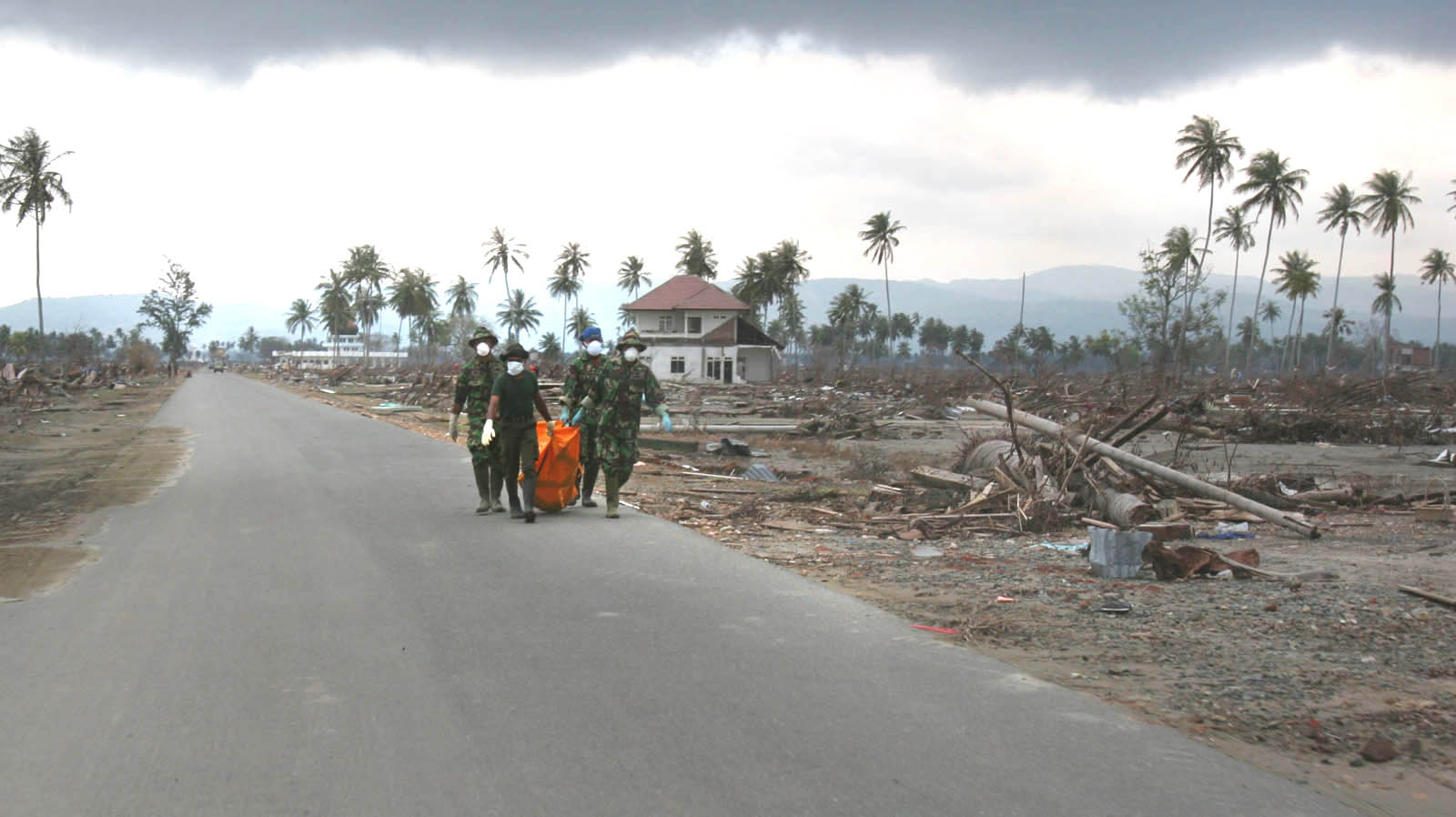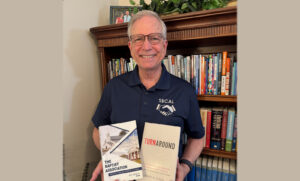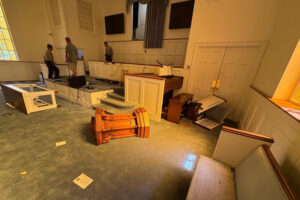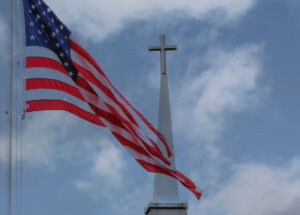
BANDA ACEH, Indonesia (BP)–The world brought food. The world brought fresh water. But, a team of Southern Baptist volunteers from Oklahoma and Georgia brought medical care and an infusion of hope for victims of the tsunami which devastated this northernmost province of Indonesia the day after Christmas.
Disaster relief director Sam Porter of the Baptist General Convention of Oklahoma led a team of a dozen volunteers with medical experience to this once-beautiful tip of land that juts out into the Indian Ocean. Once a tropical paradise, Banda Aceh’s post-tsunami landscape resembles an area left behind after a scorched-earth military campaign. The monsoon rains which are now falling may soon help clear the landscape of debris, but the tears of the Indonesian people will take months — perhaps years, perhaps forever — to help wash away the pain in their broken hearts.
Food and drinking water are no longer a problem for survivors and those responding to the tragedy.
“Every refugee camp has a kerosene stove or a wok, and they have plenty of rice to cook,” Porter said. “The world has brought the food to them. They were hungry the first week, but they have not been hungry since.”
Bodies were still being discovered three weeks after a 9.0 earthquake struck in the Indian Ocean just west of the Indonesian island of Sumatra and generated tsunamis which struck 11 different countries, killing more than 220,000 people. Banda Aceh, the Sumatran provincial capital, was the epicenter of the human suffering, with the dead estimated at more than 80,000 people.
“I think there are still thousands of bodies yet to be found,” Porter said via satellite phone in mid-January. “There are many buildings that haven’t been opened, and there’s no telling how many victims are still in the jungle.”
The reports of the numbers lost are numbing. One community near Banda Aceh once counted 2,100 members. After the tsunami hit, only 90 of them have been found. Meanwhile, the number of inhabitants of an island situated about seven miles west of the mainland has been reduced from 9,000 to 2,300.
“Truly only the youngest and strongest of them survived, because they had to run and swim to the top of a little hill to save themselves,” Porter said of the island inhabitants. “Only about 20 people over the age of 50 are left alive.
“They were without food four days, were finally brought to shore in a boat and are now settled in a refugee camp south of the coast. Most of them will not go back to the island because they’re traumatized.”
With most of the Aceh islanders’ leaders and elders gone, a small group of college students stepped up to help care for the island’s survivors, who are crammed into a refugee camp about 100 yards wide and 300 yards long some 24 miles away from the coast.
“The people running the camp are university students who were on the island doing their practice teaching and were supposed to have their graduation ceremonies that day,” Porter said. “But the tsunami hit, and they ran for their lives to the top of the hill. Many of their teachers and professors died. These 22-23-year-old kids are running the camp. I was highly impressed with how they’ve got everything organized.”
The group of refugees is living along a river, housed beneath big tents and stretched tarps. The Australian government has set up a good water filtration system there, drawing water out of the river and purifying it, so the people can bathe and wash their clothes and dishes. Bottled water is plentiful to drink.
Porter said his medical team had established a good relationship with the camp’s inhabitants. The Americans traveled to the camp specifically to conduct a day-long medical clinic for the survivors.
“They’re very open to what we’ve got going,” he said.
Medical treatment is past the emergency phase, and survivors are traumatized with headaches. Many are unable to sleep.
“For many of them, the realization is setting in that they will never see their families again,” Porter said.
The medical team did discover one case of the mumps and reported the finding to Indonesian health officials.
The monsoon rains are beginning to create another problem — the threat of malaria.
“The rain has really settled in and the mosquitoes are multiplying, so they’re looking at malaria becoming a problem,” Porter said. “The salt water has leeched back out to sea, and fresh water is coming back, so the mosquitoes are plentiful.”
Porter said Indonesian officials are trying to get survivors out of the crowded camps because they know that’s where the threat of disease looms.
He added that discussions with local officials about possible future Southern Baptist relief work in the area have been fruitful.
“We have determined that temporary housing is something our future teams can probably do,” Porter said. “Government leaders of two different areas in Aceh are very open to us helping with temporary housing, which would basically be a semi-permanent mylar tent, such as those which were used after Hurricane Mitch struck Central America in 1999.”
Providing housing in some areas where large numbers of refugees have gathered will be especially critical.
“We talked to a main government leader in the mountains just above Aceh,” Porter said. “His village’s population normally numbers about 6,500 people, but it has doubled in population since the tsunami hit. The people got as far away from the coast as they could.”
That particular village is about 25 miles up the mountain from the city.
“It’s pretty green and beautiful up there, a drastic contrast from the destruction left behind at sea level,” Porter said, adding that his group has had contact with five other communities which are situated five miles up higher in the mountains.
Porter said the devastation is similar to that left behind by the May 3, 1999, tornado that struck Oklahoma’s midsection and left some areas — particularly Moore — in shambles.
“From what I’ve seen and reports I’ve heard, there is literally nothing left standing a half-mile to a mile inland all around the basin of the Indian Ocean,” Porter said.
Porter added that the resiliency of the Indonesian people is inspiring.
“The people are hurting, of course, but they’re probably handling it a lot better than most Americans would because they live so much closer to life-altering events on a daily basis than we do in the U.S.,” Porter said.
“This is an incredibly strong community.”
Porter spoke with and encouraged a village chief before the group departed after tending to injuries of some of the villagers.
“I told him our hearts go out to him and his people, and that there are thousands of people I represent who praying for him,” Porter said. “He was very moved.”
Porter said he and his team felt safe during their trip, even though they encountered several militant rebels.
“We have actually treated local militants every day,” he said. “I have pictures of four of them we treated who walked up to us carrying machine guns. But, we loved them unconditionally, saw to their needs and we felt very safe.”
The Oklahomans and Georgians were escorted around the province by four local college-age students who acted as interpreters.
“There should be many tremendous opportunities to serve here in the future. We have to be ready to love on these hurting people for a long time to come,” he said.
–30–















